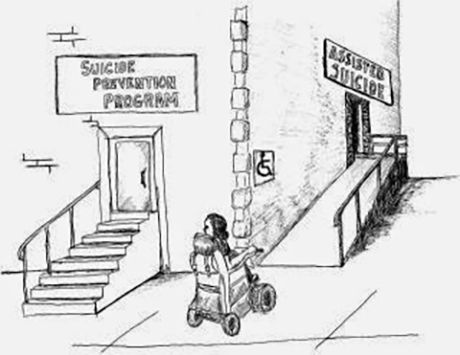Features
You are here
Life, death, dignity, and the state

April 13, 2016
The right to choose when and how we die, on its surface, may seem like something the government has no business deciding. Perhaps that’s why the Supreme Court of Canada struck down the law prohibiting physician-assisted death in 2015. Effective June 6, physician-assisted death will be a funded part of Medicare across Canada. The federal government has until that date to decide just what should be funded, and under what circumstances.
The choice to live or die may seem liberating to some, but that choice is also somewhat of an illusion—layered with the familiar trappings of capitalism and oppression. In a country where poverty, gender roles, austerity and discrimination are a daily aspect of people’s lives, a state-approved right to die may sound more like a quiet suggestion than a mere option.
As the Council of Canadians with Disabilities (CCD) state in the opening paragraph in their Submission to Special Joint Committee on Physician Assisted Dying, “the Supreme Court of Canada in Carter emphasized that there needs to be a balanced system that both enables access by patients to physician-assisted suicide and voluntary euthanasia (PAD/VE), and protects persons who are vulnerable and may be induced to commit suicide.” The CCD Submission also stated risk factors for suicide included socio-economic factors, race, ethnicity, and culture, or onset of physical disability.
As Toronto Star reporter Thomas Walkom wrote in a recent article, “All of this might make eminent sense in a world where everyone (including every teenager) was rational, where physicians were all-seeing, where family members always had one another’s interests at heart and where the old, sick and disabled were not viewed as social burdens.”
Truthfully, assisted deaths have been a quiet occurrence in this country for a long time, but now that such deaths are permitted by the state, it’s necessary to consider the role government has in these decisions.
Quebec has consulted with the public since the Carter case began, and has since come out with Bill 52—which is quite narrow in scope. The Ontario government so far has made a number of recommendations without appearing to consider the research. The federal government however, is making some interesting decisions. First, it took power away from the existing federal committee to make any recommendations, then appointed its own committee made up of MPs and Senators. According to a recent article by the Globe and Mail “The majority of the parliamentary committee seeks to expand the criteria for physician-assisted death way beyond what was required by Carter or Bill 52. It includes mental-health conditions and all other disabilities, including developmental disabilities, autism, acquired brain injuries, fetal alcohol syndrome, not to mention blindness and deafness.”
So how do we as activists fit in to these unfolding events? While respect for the personal choice of individuals is important, it is equally important to consider the context of those decisions, and for whom laws get made. As the federal government and mainstream movements continue to waffle on the subject of oppression, it is up to us to continue to highlight oppression and discrimination to the forefront. The right to die can never be equitable without the right to live with dignity.
If you’d like to hear more on this topic, please join us for the Disability Rights and Physician Assisted Suicide Panel on Saturday April 23rd as part of Ideas for Real Change: Marxism 2016.
Note: There is a call for a Vulnerable Persons Standard. It addresses some of this issues, but without the context of ableism and other forms of oppression. The writers of this standard are currently looking for signatures.
Section:
Topics:










